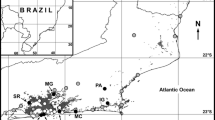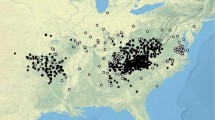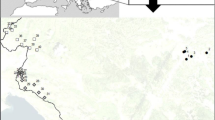Abstract
A good knowledge of species distributions and their genetic structure is essential for numerous types of research such as population genetics, phylogeography, or conservation genetics. We document the presence of extremely local populations of three butterfly species (Iolana iolas, Satyrus ferula and Melanargia larissa) in the Romanian fauna. Satyrus ferula and M. larissa are reported for the first time in the country, while I. iolas is rediscovered following presumed extinction. Based on mitochondrial DNA (cytochrome c oxidase subunit 1—COI sequences), we assessed the genetic structure of these populations and placed them into a broader context through comparisons with other populations from across the range of these species. Each of the three species had a single haplotype in Romania, suggesting low female effective population size possibly under genetic erosion. Two of the populations (S. ferula and M. larissa) are genetically unique, displaying endemic haplotypes in south-western Romania. The Romanian populations of the three species likely remained unnoticed due to their extremely limited extent of occurrence. Their restricted range, close to the northern limits of distribution in the Balkans, their apparent low female effective population size, the presence of endemic haplotypes, and habitat vulnerability (especially for I. iolas) highlight the need for monitoring and conservation measures for the safeguarding of these populations.
Implications for insect conservation
We discover and study the genetics of previously unknown populations of three butterfly species (Iolana iolas, Satyrus ferula and Melanargia larissa) in Romania, which deserve conservation measures. This study exemplifies how biodiversity exploration and genetic information can contribute to informed decisions regarding the management and protection of threatened populations.






Similar content being viewed by others
Data availability
DNA sequences generated as a result of this study were submitted to GenBank and the entire dataset, including GenBank accession numbers and sampling sites, is publicly available in the dataset DS-ROLEP2 from the Barcode of Life Data Systems (https://www.boldsystems.org/).
References
Antonovics J, McKane AJ, Newman TJ (2006) Spatiotemporal dynamics in marginal populations. Am Nat 167:16–27. https://doi.org/10.1086/498539
Clement M, Posada D, Crandall KA (2000) TCS: a computer program to estimate gene genealogies. Mol Ecol 9:1657–1660. https://doi.org/10.1046/j.1365-294x.2000.01020.x
Dapporto L, Cini A, Vodă R, Dincă V, Wiemers M, Menchetti M, Magini G, Talavera G, Shreeve T, Bonelli S, Casacci LP, Balletto E, Scalercio S, Vila R (2019) Integrating three comprehensive datasets shows that mitochondrial DNA variation is linked to species traits and paleogeographic events in European butterflies. Mol Ecol Resour 19(6):1623–1636. https://doi.org/10.1111/1755-0998.13059
deWaard JR, Ivanova NV, Hajibabaei M, Hebert PDN (2008) Assembling DNA barcodes. In: Martin CC (ed) Environmental genomics, methods in molecular biology, vol 410. Humana Press, Totowa, pp 275–293
Dincă V, Vila R (2008) Improving the knowledge on the Romanian Rhopalocera, including the rediscovery of Polyommatus amandus (Schneider, 1792) and an application of DNA-based identification. Nota Lepidopterol 31:3–23
Dincă V, Székely L, Kovács S, Kovács Z, Vila R (2008) Pyrgus andromedae (Wallengren, 1853) (Hesperiidae) in the Romanian Carpathians. Nota Lepidopterol 31:263–272
Dincă V, Cuvelier S, Székely L, Vila R (2009) New data on the Rhopalocera (Lepidoptera) of Dobrogea (south-eastern Romania). Phegea 37:1–21
Dincă V, Cuvelier S, Zakharov EV, Hebert PDN, Vila R (2010) Biogeography, ecology and conservation of Erebia oeme in the Carpathians. Ann Soc Entomol Fr 46:486–498
Dincă V, Kolev Z, Verovnik R (2010) The distribution, ecology and conservation status of the Spinose Skipper Muschampia cribrellum (Eversmann, 1841) at the western limit of its range in Europe (Hesperiidae). Nota Lepidopterol 33:39–57
Dincă V, Cuvelier S, Mølgaard MS (2011) Distribution and conservation status of Pseudophilotes bavius (Eversmann, 1832) (Lepidoptera: Lycaenidae) in Dobrogea (south-eastern Romania). Phegea 39:59–67
Dincă V, Zakharov EV, Hebert PDN, Vila R (2011) Complete DNA barcode reference library for a country’s butterfly fauna reveals high performance for temperate Europe. Proc R Soc B 278:347–355
Dincă V, Montagud S, Talavera G, Hernández-Roldán J, Munguira ML, García-Barros E, Hebert PDN, Vila R (2015) DNA barcode reference library for Iberian butterflies enables a continental-scale preview of potential cryptic diversity. Sci Rep 5: 12395. https://www.nature.com/articles/srep12395
Dincă V, Székely L, Bálint Z, Skolka M, Török S, Hebert PDN (2017) Improving knowledge of the subgenus Agrodiaetus (Lepidoptera: Lycaenidae) in Eastern Europe: overview of the Romanian fauna. Eur J Entomol 114:179–194. https://doi.org/10.14411/eje.2017.023
Gaston KJ (2009) Geographic range limits: achieving synthesis. Proc R Soc Lond B 276:1395–1406. https://doi.org/10.1098/rspb.2008.1480
Hausmann A, Haszprunar G, Segerer AH, Speidel W, Behounek G, Hebert PDN (2011) Now DNA-barcoded: the butterflies and larger moths of Germany. Spixiana 34(1):47–58
Hebert PDN, Cywinska A, Ball SL, deWaard JR (2003) Biological identifications through DNA barcodes. Proc R Soc B 270:313–321. https://doi.org/10.1098/rspb.2002.2218
Hebert PDN, Penton EH, Burns JM, Janzen DH, Hallwachs W (2004) Ten species in one: DNA barcoding reveals cryptic species in the neotropical skipper butterfly Astraptes fulgerator. Proc Natl Acad Sci USA 101(41):14812–14817. https://doi.org/10.1073/pnas.0406166101
Huemer P, Wiesmair B (2017) DNA-barcoding der Tagfalter (Lepidoptera, Papilionoidea) Österreichs.—unbekannte genetische Vielfalt im Zentrum Europas. Wissenschaftliches Jahrbuch der Tiroler Landesmuseen, pp. 8–33
Ivanova NV, deWaard JR, Hebert PDN (2006) An inexpensive, automation-friendly protocol for recovering high quality DNA. Mol Ecol Notes 6:998–1002. https://doi.org/10.1111/j.1471-8286.2006.01428.x
Jump AS, Peñuelas J (2005) Running to stand still: adaptation and the response of plants to rapid climate change. Ecol Lett 8:1010–1020. https://doi.org/10.1111/j.1461-0248.2005.00796.x
König F (1975) Catalogul colecţiei de lepidoptere a Muzeului Banatului, Timișoara. Muzeul Banatului, Timişoara
König F (1979) Consideraţii ecologice, sistematice şi zoogeografice asupra lepidopterelor caracteristice piemonturilor vestice între Mureş şi Dunăre. Tibiscus Ştiinţe Naturale, Muzeul Banatului, Timişoara, pp. 109-119
König F (1998) Lepidopterologische Forschungen im Banater Karstgebiet. Nachrichten des Entomologischen Vereins Apollo 19(1):89–100
Kudrna O (2019) Distribution of Butterflies and Skippers in Europe. Společnost pro Ochranu Motýlů (SOM), Prachatice
Kunin WE, Vergeer P, Kenta T, Davey MP, Burke T, Woodward FI, Quick P, Mannarelli ME, Watson-Haigh NS, Butlin R (2009) Variation at range margins across multiple spatial scales: environmental temperature, population genetics and metabolomic phenotype. Proc R Soc B 276:1495–1506. https://doi.org/10.1098/rspb.2008.1767
Miljević M, Đurić M (ed) (2014–2020) Alciphron-baza podataka o insektima Srbije (Lepidoptera: Papilionoidea), HabiProt Acessed 15 May 2020 from https://www.alciphron.habiprot.org.rs.
Nazari V, Ten Hagen W, Bozano GC (2010) Molecular systematics and phylogeny of the ‘Marbled Whites’ (Lepidoptera: Nymphalidae, Satyrinae, Melanargia Meigen). Syst Entomol 35:132–147. https://doi.org/10.1111/j.1365-3113.2009.00493.x
Oprea A (2005) Lista critică a plantelor vasculare din România. Editura Universității “Alexandru Ioan Cuza”, Iași
Popescu-Gorj A (1959) Date noi asupra Lepidopterelor din Dobrogea. Acad RPR Stud şi Cerce Biol ser Biol Anim 11(1):7–25
Popescu-Gorj A, König F, Peiu M, Niculescu E, Ionescu M, Draghia I, Tudor C, Botoc M (1972) Species new for Romania’s fauna. The “Iron Gate” Complex Atlas. Editura Academiei Republicii Socialiste Romania
Rákosy L (ed) (1997) Entomofauna parcurilor naţionale Retezat şi Valea Cernei. Societatea Lepidopterologică Română, Cluj-Napoca
Rákosy L (2003) Lista roșie pentru fluturii diurni din România. Buletin Informare Societatea Lepidopterologică Română 13 (1–4)/2002: 9–26
Rákosy L (2013) Fluturii diurni din România. Cunoaștere, protecție, conservare. Editura MEGA, Cluj-Napoca
Rákosy L, Goia M, Kovács Z (2003) Catalogul Lepidopterelor României. Societatea Lepidopterologică Română, Cluj-Napoca
Rákosy L, Schmitt T, Varga Z (2011) Erebia oeme (Hübner, 1804) (Lepidoptera, Nymphalidae) in the Făgăraș Mountains (Southern Carpathians). Entomol Rom 16:19–22
Rebel H (1911) Die Lepidopterenfauna von Herkulesbad und Orşova. Eine zoogeographische Studie. Annalen des k. k. Naturhistorischen Hofmuseums Wien 25:17–430
Rothschild NCh (1912) Adatok Magyarország lepkefaunájához. Rovartani Lapok 19(10–12): 167–180. https://epa.oszk.hu/02300/02371/00173/pdf/
Schweiger O, Harpke A, Wiemers M, Settele J (2014) CLIMBER: climatic niche characteristics of the butterflies in Europe. ZooKeys 367:65–84. https://doi.org/10.3897/zookeys.367.6185
Sexton JP, McIntyre PJ, Angert AL, Rice KJ (2009) Evolution and ecology of species range limits. Ann Rev Ecol Evol Syst 40:415–436. https://doi.org/10.1146/annurev.ecolsys.110308.120317
Stănoiu I, Bobârnac B (1965) Contribuții la studiul lepidopterelor din Oltenia (I). Soc Șt Nat Geogr Com Zool București 3:215–226
Székely L (2008) The butterflies of Romania. Brastar Print, Brașov
Tshikolovets VV (2011) Butterflies of Europe & the Mediterranean area. Tshikolovets Publications, Pardubice
van Swaay C, Cuttelod A, Collins S, Maes D, Lopez Munguira M, Šašić M, Settele J, Verovnik R, Verstrael T, Warren M, Wiemers M, Wynhoff I (2010) European red list of butterflies. Publications Office of the European Union, Luxembourg
Wiemers M, Balletto E, Dincă V, Fric ZF, Lamas G, Lukhtanov V, Munguira ML, van Swaay CAM, Vila R, Vliegenthart A, Wahlberg N, Verovnik R (2018) An updated checklist of the European Butterflies (Lepidoptera: Papilionoidea). Zookeys 811:9–45. https://doi.org/10.3897/zookeys.811.28712
Yang A, Dick CW, Yao X, Huang H (2016) Impacts of biogeographic history and marginal population genetics on species range limits: a case study of Liriodendron chinense. Sci Rep 6:25632. https://doi.org/10.1038/srep25632
Acknowledgements
We are grateful to all the colleagues who provided samples used in this study. We thank A. Choch, S. Cuvelier, E. Karolinskiy, M. Popović and M. Šašić for information regarding the distribution of the three species in various regions. We also thank A. Dumbravă from the Iron Gates Natural Park. We are grateful to Zs. Bálint for facilitating access to the collections of the Hungarian Museum of Natural History, Budapest. VD acknowledges the Visiting Professor fellowship awarded by the Research Institute of the University of Bucharest.
Funding
Support for this research was provided by a Marie Curie International Outgoing Fellowship within the 7th European Community Framework Programme (project no. 625997) and by the Academy of Finland to V. Dincă (decision no. 328895), and by PID2019-107078GB-I00/AEI/10.13039/501100011033 to R. Vila.
Author information
Authors and Affiliations
Contributions
All authors contributed to the study’s conception and design. Material preparation and data collection were performed by all authors. Genetic analyses were performed by Vlad Dincă and Raluca Vodă. The first draft of the manuscript was written by Bogdan Groza and Vlad Dincă and all authors commented on previous versions of the manuscript. All authors read and approved the final manuscript.
Corresponding author
Ethics declarations
Conflict of interest
The authors declare that they have no conflict of interest.
Additional information
Publisher's Note
Springer Nature remains neutral with regard to jurisdictional claims in published maps and institutional affiliations.
Electronic supplementary material
Below is the link to the electronic supplementary material.
Rights and permissions
About this article
Cite this article
Groza, B., Vodă, R., Székely, L. et al. Genetics and extreme confinement of three overlooked butterfly species in Romania call for immediate conservation actions. J Insect Conserv 25, 137–146 (2021). https://doi.org/10.1007/s10841-020-00281-9
Received:
Accepted:
Published:
Issue Date:
DOI: https://doi.org/10.1007/s10841-020-00281-9




